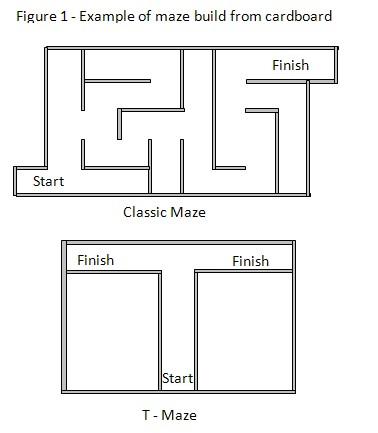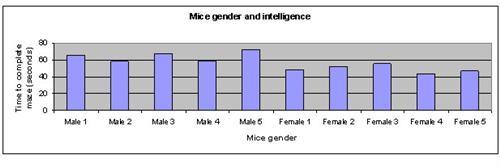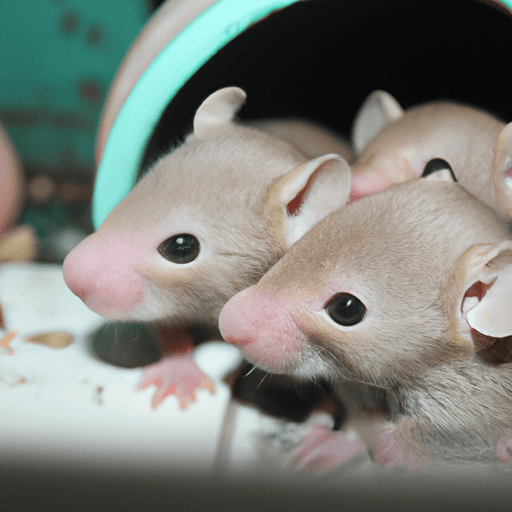| Complexity level: | 4 |
| Time required: | It will take 2 days to prepare for this science fair project, and 2 days to observe the experiment |
| Material availability: | The mice can be purchased at a pet store. The other materials can be easily found at a bookstore or supermarket |
| Safety concerns: | You should wear a pair of gloves when handling the rodents. This is to prevent getting bitten by the mice. |
Hypothesis
Female mice will learn faster than the male mice. They also tend to be right handed (or perhaps it may be more accurate to say "right-pawed"). The male mice tend to be left pawed.
Overview
Mice
Mice are mammals and are part of the rodent family. They have very thin fur, long tails and surprisingly, poor eyesight. However, mice have a very acute sense of smell and hearing. They use these senses to find food and to avoid enemy predators.
Mice are seldom kept as pets in the home. Normally, they enter the home to scavenge for food. This is done without our knowledge. Mice carry and spread harmful diseases. This is why we should immediately dispose of food that has been nibbled on by mice.
Mice used to live on farms. They caused many problems because they fed on farm crops, damaging them. This is why farmers rear - cats to keep the mice away. Snakes were used in large plantations as a biological means of controlling mice population. When forests and farms were cleared to make way for urbanization, mice adapted to living in city sewage systems and drains.
Mice also have a very high rate of reproduction and they have genetic similarities to human beings. This makes them ideal as a lab animal.
Scientific Terms
Materials
The materials required for the experiment are as follows:
- 5 male mice
- 5 female mice
- a stack of cardboard or old carton boxes (make sure that there are enough boards or boxes to make 2 mazes)
- a pair of scissors
- a roll of masking tape
- a bottle of glue
- a stopwatch
- a 1meter ruler
Procedure
1. For this science project, the independent variable is the mice’s gender. The dependent variable is the amount of time the mice take to complete a maze, and whether they prefer to use their left or right paws. Use a stopwatch to time the mice. Observe also, which paws the mice tend to use. The constants (control variables) are the size and type of the maze, the condition the mice are in (they should be kept hungry for the experiment), and the type of food used.
2. Make a classic maze and a T-maze approximately the size 500 millimeters x 800 millimeters using a pile of cardboard, a bottle of glue and a roll of masking tape. The maze must be at least 200mm tall so that the rodents cannot jump out. See figure 1 for an example of the 2 mazes.
3. Leave the completed mazes to dry for 2 days. This will allow the smell of the glue to dissipate. Otherwise, the mice will be able to smell the glue, and this will distract them.

4. First, test the mice using the classic maze. Place a sunflower seed at the finish line and release the mice at the start line. Time how long the mice take to find the food. Repeat the test 5 times on each mouse. There should be a 30 minute interval between each test. Record the fastest timing for each mouse in the table below.
5. The next day, the paw-preference test is performed using the T-maze. One sunflower seed is placed in each finish zone of the T-maze and the mice are placed in the start zone (one at a time). Observe whether the mice end up on the left or the right side of the T-maze. The test is done 5 times and the most preferred side for each mice are recorded in the table below.


Results
The female mice completed the classic maze faster than the male mice. The female mice were right pawed while 80% of the male mice were left handed.
| Test maze | Mice behavior – speed in completing maze and paw preference | |||||||||
| Male 1 | Male 2 | Male 3 | Male 4 | Male 5 | Female 1 | Female 2 | Female 3 | Female 4 | Female 5 | |
| Classic maze –time (seconds) | 65 | 58 | 67 | 59 | 72 | 48 | 52 | 55 | 43 | 47 |
| T-maze- paw preference | Left | Right | Left | Left | Left | Right | Right | Right | Right | Right |
The graph below represents the results of our science project:

Conclusion
The hypothesis holds true: the female mice learned faster than the male mice. They also tended to be right pawed. The male mice tended to be left pawed.
Mice and rats have similar genes as human beings,. making them suitable for tests that cannot be performed on human beings. There are many kinds of mazes that test mice for their memory and learning abilities. Mice have a natural ability when it comes navigating mazes because their natural habitats (ie: underground tunnels) are similar to mazes.
Also consider
Use hamsters instead of mice.
Use different kinds of mazes and feeds.
What happens if the experiment is conducted in complete darkness?
What if a strong scent (eg. air freshener) permeates through the entire maze. How will that affect the performance of the mice?
References
Rats and mazes - http://www.ratbehavior.org/RatsAndMazes.htm
Mouse - http://en.wikipedia.org/wiki/Mouse

